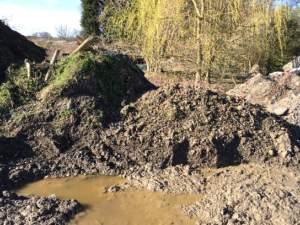Remediation Waste & Testing
14th August 2021
With much industry confusion relating to ‘waste’ generated from earthworks and remediation, and how this is characterised, Northpoint provides professional insight
What is Waste?
For any remediation scheme, when is material considered waste? DEFRA provides a legal definition of waste in the 2008 Waste Framework Directive:
“any substance or object whi ch the holder discards or intends or is required to discard”
ch the holder discards or intends or is required to discard”
Firstly, Annexe 1 of DEFRA Publication: Guidance on the legal Definition of waste and its application (August 2012) provides more detail, however breaking this definition down for the construction industry, this is considered – any material that cannot be reused (i.e. as capping, earthworks fill etc.) and has to be exported offsite as waste.
There is a common misconception that contaminated or undesirable materials are automatically waste. Consequently, in terms of any remediation scheme, waste disposal should be considered the least favourable option.
Whilst materials may be ‘contaminated’, they may possess certain characteristics that allow them to be placed as capping or general/special fill (i.e. below a highway, beneath a driveway, or to fill a large void). Most noteworthy, provided contaminated materials once placed will not pose a risk to the completed development, the above is in theory acceptable.
Often, sites have a surplus of material. Furthermore, this may include natural/clean materials excavated from the ground. If this material cannot be sold on, it is considered unwanted, and therefore considered as a waste when considering the legal definition.
Where unwanted materials are removed from a site, these are considered waste, but how can these materials be adequately characterised?
Making an Appropriate Assessment is key
Northpoint, through third-party review of ground investigations, often see inadequate waste classification. Above all, why is this? Largely due to the expense of chemical testing and/or a lack of understanding of testing requirements.
Before accepting a waste, a landfill will require evidence of adequate site investigation testing data as well as Waste Acceptance Criteria (WAC) testing certificates. The WAC testing certificate categorises waste into one of three groups:
- Inert waste
- Non-reactive hazardous waste
- Hazardous waste
How many WAC tests are required for a basic characterisation?
| Population (tonnes) | Homogeneous
Material |
Heterogeneous &
New Wastes |
| No. of samples required | ||
| <100t | 2 | 5 |
| <500t | 3 | 8 |
| <1000t | 5 | 14 |
| 10,000t | 11 | 22 |
| Plus per additional 10,000t | +5 (pro rata) | + 10 (pro rata) |
Source: Environment Agency (2013)
If you require any further information or support relating to remediation and waste classification, Northpoint is happy to assist. Lastly, contact our Geoenvironmental engineering teams who can assist with your project.
0191 917 3210
info@northpointgeotechnical.com


